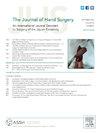The Mangled Digit Severity Score: Determining Salvageability of Severe Digital Injuries
IF 2.1
2区 医学
Q2 ORTHOPEDICS
引用次数: 0
Abstract
Purpose
The assessment, prognostication, and decision-making for mangled digital injuries can be challenging, even for experienced surgeons. This study aimed to develop a Mangled Digit Severity Score (MDSS) to predict whether a mangled digit should be salvaged.
Methods
An anonymous questionnaire was sent to 67 hand surgeons at seven hand trauma centers as an initial survey panel. Participants were provided a list of factors influencing outcomes following a mangled digit injury and were asked to assign weights from 0–10 for each factor reflecting its relative importance in determining likelihood of functional salvage versus failure or secondary amputation. Using a modified Delphi method, iterative questionnaire rounds then were performed with seven expert panelists and consensus established. The final ratings were used to develop a weighted scoring system to assess mangled digits. A retrospective single-center review was conducted to validate the scoring system. The sensitivity and specificity for amputation at different MDSS prognostic thresholds were evaluated, and a receiver operating characteristic curve and area under the curve were calculated.
Results
From initial surgeon responses (36/67 response rate) and two subsequent rating rounds, consensus was achieved on 14 factors, including crush/avulsion mechanism, intraarticular fracture, and zone II flexor tendon injury. Final weights for all factors ranged between 3–9. Among 54 mangled digits reviewed, digits that were salvaged had a significantly lower MDSS than those that underwent amputation. The MDSS demonstrated an area under the curve of 0.87. At a threshold of 35, the MDSS achieved a sensitivity of 60% and specificity of 88% in predicting amputation.
Conclusions
The MDSS was developed through a consensus of experts and is a useful tool for identifying mangled digits that may not be salvageable.
Clinical relevance
The MDSS provides a structured framework for the assessment of severely injured digits with a prognostic guideline for amputation or salvage.
断指严重程度评分:确定严重数字损伤的可挽救性。
目的:即使是经验丰富的外科医生,对手指损伤的评估、预测和决策也是具有挑战性的。本研究旨在建立骨折严重程度评分(MDSS)来预测骨折是否需要抢救。方法:对7家手外伤中心的67名手外科医生进行匿名问卷调查。参与者被提供了一份影响断指损伤后结果的因素列表,并被要求为每个因素分配0-10的权重,以反映其在决定功能恢复与失败或继发性截肢可能性方面的相对重要性。采用改进的德尔菲法,对7位专家小组成员进行了反复问卷调查,并建立了共识。最终的评分被用来开发一个加权评分系统来评估破损的数字。进行回顾性单中心评价以验证评分系统。评估不同MDSS预后阈值截肢的敏感性和特异性,并计算受试者工作特征曲线和曲线下面积。结果:从最初的手术反应(36/67反应率)和随后的两轮评分中,我们在14个因素上达成了共识,包括挤压/撕脱机制、关节内骨折和II区屈肌腱损伤。所有因素的最终权重在3-9之间。在54个残缺的手指中,被抢救的手指的MDSS明显低于截肢的手指。MDSS曲线下面积为0.87。在阈值为35时,MDSS预测截肢的灵敏度为60%,特异性为88%。结论:MDSS是通过专家共识开发的,是识别可能无法修复的破损手指的有用工具。临床意义:MDSS提供了一个评估严重受伤手指的结构化框架,并提供了截肢或保留的预后指南。
本文章由计算机程序翻译,如有差异,请以英文原文为准。
求助全文
约1分钟内获得全文
求助全文
来源期刊
CiteScore
3.20
自引率
10.50%
发文量
402
审稿时长
12 weeks
期刊介绍:
The Journal of Hand Surgery publishes original, peer-reviewed articles related to the pathophysiology, diagnosis, and treatment of diseases and conditions of the upper extremity; these include both clinical and basic science studies, along with case reports. Special features include Review Articles (including Current Concepts and The Hand Surgery Landscape), Reviews of Books and Media, and Letters to the Editor.

 求助内容:
求助内容: 应助结果提醒方式:
应助结果提醒方式:


